Lead (Tetra-ethyl lead - TEL to be precise) as a gasoline additive was used for two reasons, as an anti-knock medium and as a lubricant. It boosted the octane-rating of a fuel by increasing the pressure that the gasoline would eventually self-ignite and with residues formed especially in the valve seats reduced wear inside the engine.

The problem with use of lead is primarily it is a dangerous and toxic poison and also it destroys the catalytic converters that most cars use the last 20 years. Catalytic converters were introduced in the late 80's and today exist in almost every car and in many motorcycles. With catalytic converters the unleaded petrol was introduced alongside the regular one (super as it was called in Greece).
Unleaded petrol instead of lead has other anti-knock mediums like aromatic hydrocarbons like benzene. These substances by themselves are harmful to human but an engine with lambda sensor and catalytic converter can reduce them to simpler and mostly harmful ones like carbon dioxide or monoxide.
For the older non-catalytic cars the regular leaded petrol was still available for many years in the market until it was replaced after the lead ban from LRP (lead replacement petrol). The fuel type of such vehicles is an interesting subject that can be examined from two viewpoints, engine wear and atmospheric pollution.
Pollution.
As we mentioned above, unleaded petrol contain aromatic hydrocarbons, a family of very harmful for man substances. A catalytic converter equipped car doesn't allow them to reach the atmosphere, it reduces them to simpler and -mostly- harmless ones, but a non catalytic car allow them a lot of them to escape to the atmosphere through the exhaust gases. At the time unleaded petrol was introduced the regular petrol was still available, there was a common belief that it is criminally ignorant to use unleaded petrol in a non-catalytic car because of the pollutants it produced. However there are two big misunderstandings.

With the introduction of unleaded the amount of lead in the regular gasoline started to decrease. Lead was used simply as a lubricant were a tiny amount is sufficient and as an anti-knock medium the same substances that unleaded fuel used (aromatic hydrocarbons) were added. Thus a non-catalytic car that consumed regular leaded fuel just before the lead ban emitted in the atmosphere about the same amounts of benzene etc as if it used unleaded gasoline. Of course after the lead ban and the introduction of LRP the aromatic hydrocarbons emissions either with LRP or regular unleaded were exactly the same, because LRP is regular unleaded petrol with the addition of some small amount of engine lubricant substances.
However even today that LRP is almost universally discontinued many consumers believe that it is irresponsible and dangerous to use regular unleaded in a non-catalytic car (even if the engine has no problem using it).

The second misunderstanding was how dangerous the aromatic hydrocarbons were in comparison with the toxicity of lead. Most studies converge to the fact that lead is orders of magnitude more dangerous than aromatic hydrocarbons. It would probably be better if lead had never been used in fuels from the start, other anti-knock additives would be much safer. Of course aromatic hydrocarbons are still very harmful but they are the lesser of two evils. Even when unleaded was first introduced it would be much safer for any car (even without a catalytic converter) to use it despite the fear that many journalist or magazines inspired to the public. During that transition period many non-catalytic cars (ex Nissan) or motorcycles (ex Piaggio) were sold with the permission and incitement of the constructor for use of unleaded gasoline.
Engine wear.
Lead was also used as an engine lubricant, especially for valve seats. That is the main reason that a small amount of lead was retained in the regular leaded petrol even when aromatic hydrocarbons were added as a main anti-knock medium. That is the main reason for the existence of LRP after the lead ban. LRP had lubricant additives for the older cars that needed them for their valve seats. It was nothing else than regular unleaded with some add-ons.
However most non-catalytic cars or motorcycles we use today doesn't need any special fuel, their engines have all the required alloys and treatments in order to operate safely without any special lubricant from the fuel. Also, many engineers say that the wear from lead residues from the use of leaded petrol was much worse than the wear from the lack of lubrication and that even in those cars regular unleaded would be preferable to leaded petrol.
If however your car needs this lubricants even after the discontinuation of LRP (less than 3% of the cars needed it) there will be on the market separately sold additives that you can put in the gasoline in small doses and have the same effect with LRP.

Another possibly important fatctor is the octane-rating. The commonly used leaded petrol ("super") had 98-octane rating and now the regular unleaded and LRP have 95. Some older cars may need 98-octane petrol and cannot operate correctly with 95. In these cases you can use high-octane petrol without problem even in mix with regular unleaded or LRP.